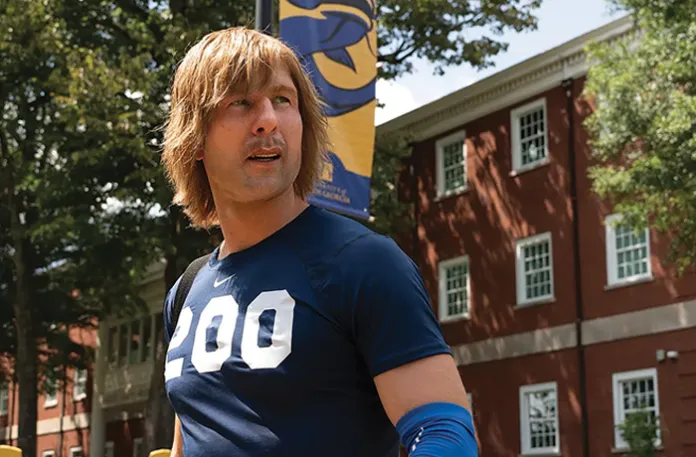There Will Be Buffoonery: Review of ‘One Battle After Another’
The article is a review of the film *One Battle After Another*, directed by paul Thomas Anderson and starring Leonardo DiCaprio.It discusses DiCaprio’s career,noting that while he has delivered strong performances in the past,especially in films like *Catch Me If You Can*,*the Aviator*,and *The Departed*,his recent work suggests his talent is less fresh,with his performances relying on familiar acting habits. In *One Battle After Another*, DiCaprio plays “Ghetto” Pat Calhoun, a radicalized father involved in left-wing activist violence. The film is described as a politically charged, surreal depiction of a fracturing America, featuring strong visual storytelling, especially a memorable high-speed chase scene through California’s desert landscape. However, the screenplay is criticized as self-indulgent and ham-fisted, filled with provocative but uneven political messaging that satirizes both radical activists and reactionaries. The story centers on Pat’s search for his missing teenage daughter Willa, who symbolizes hope and the potential for democratic reform. the movie is praised for its direction and mood but is seen as flawed in writing and overly long, appealing mainly to niche audiences interested in leftist themes and political commentary.
There will be buffoonery: Review of ‘One Battle After Another’
“How does Leonardo DiCaprio get away with it?” ask the clickbait warriors at Slate. The question concerns the actor’s well-chronicled love of superyachts and 20-year-olds, but it might just as easily be posed of the Oscar winner’s choice of projects. In the 21st century thus far, DiCaprio has made exactly two movies that weren’t directed by a household name — Edward Zwick’s Blood Diamond (2006) and R. D. Robb’s Don’s Plum (2001). His other 18 collaborations are a veritable who’s who of American cinema: Martin Scorsese, Christopher Nolan, Quentin Tarantino, and on the list goes.
One possible answer is that the 50-year-old really is that talented. Certainly, he has given some fine performances, most notably during a three-picture run in the early-to-mid aughts. Catch Me If You Can (2002), perhaps Steven Spielberg’s last great movie, represented the culmination of the actor’s Peter Pan phase and remains thrilling more than two decades later. The Aviator (2004), now undeservedly neglected, depends so heavily on its star’s peppery charisma that it barely lets him offscreen for a moment. Best of all was The Departed (2006), in which DiCaprio reached new heights of aggression, vulnerability, and pathos. Not since John Cazale made The Godfather Part II (1974), Dog Day Afternoon (1975), and The Deer Hunter (1978) in sequence has a five-year stretch of acting been quite so bracing.
Yet it is also the case that DiCaprio the brand has largely supplanted DiCaprio the artist in recent years. In part, this was an inevitable consequence of the performer’s choosiness. Coming as infrequently as they do, his films have begun to feel more like events than mere movies. Also true, however, is that a certain laziness now attends DiCaprio’s work onscreen. Watch with any attention, and one begins to see his tricks: the squinty perplexity, the restless hands, the worry lines deepened in concentration, then suddenly relaxed.
All three of these moves are on display in One Battle After Another, DiCaprio’s latest leading turn and the 10th full-length feature from writer-director Paul Thomas Anderson. A story of family and radicalization, the new film is further proof that the actor’s smartest work is probably behind him. As “Ghetto” Pat Calhoun, a far-left revolutionary turned dissipated father, DiCaprio gives his all to a role that is alternately panicked, confused, and violently belligerent. Nevertheless, the impression one gets is of a performer who is sorely out of practice. Though still watchable well into middle age, DiCaprio is no longer, on his own, an excuse to visit the cinema.
To be sure, there are other reasons to see Anderson’s new movie. Already hailed as a masterpiece in some quarters, One Battle After Another will appeal strongly to antifa bros who feel unrepresented onscreen. The film’s first half-hour chronicles leftist subversion with documentary precision, as Pat and company bomb campaign headquarters and attempt to take down California’s power grid. Similarly pleased will be Sean Penn’s three or four remaining fans. The actor plays Col. Steven J. Lockjaw, a randy Javert who hunts and lusts after Pat’s girlfriend, Perfidia (Teyana Taylor), with obsessive panache.
If called upon to reduce the movie’s action to a single sentence, I might settle on the following: When his teenage daughter, Willa (Chase Infiniti), goes missing, Pat must find her before Lockjaw and other villains can. Indisputably, however, One Battle After Another cares more about tone than plot. Like Magnolia (1999), Anderson’s divisive third feature, the new film settles well beyond the boundaries of realism, providing instead a half-surreal excursion through Nightmare Nation. Driven by Jonny Greenwood’s relentless score, the movie summons not only the images but the psycho-spiritual sensations of a country tearing itself apart.
Anderson can plainly do anything he wants behind a camera. Note his equal facility framing a romantic breakup and capturing a sweaty-palmed bank-heist getaway. If a single scene in One Battle After Another has a chance to become iconic, it is a three-car chase over the undulating hills of California’s Anza-Borrego Desert State Park. There, Pat, Willa, and an assassin follow one another across terrain that bucks and dips like a cartoon water hose. The race is tense, well-designed, and brilliantly shot and edited. If Anderson had trimmed an hour from his 162-minute run time and leaned into visual storytelling, he might have made one of the finest and most exciting movies of 2025.
Instead, and not for the first time, the auteur’s screenwriting has failed to live up to his location scouting and directing. Among the new movie’s strengths is its use of the Golden State as a canvas, a move that provides Anderson with stunning political and natural geographies to explore. Where else but California could a burning city give way to desert isolation in mere moments? Where else could Benicio del Toro play a character named Sensei? Rescued repeatedly by Anderson’s surehandedness as an entertainer, One Battle After Another is clearly the best picture that could have been made from so self-indulgent a script. The finished product is frustrating, ham-fisted, and mindlessly provocative, but it is never, even for a minute, dull.
Much will be made of the film’s outrageous politics, which seem, at a glance, to give cover to ideologically progressive violence provided its perpetrators’ hearts are in the right place. In fact, Anderson is laughing at both sides while the world burns. Yes, the movie’s reactionaries are ridiculous, never more so than when Penn’s comic-book antagonist is onscreen. But Pat and Perfidia’s movement is little better. Take, for instance, a scene in which a harried Pat gets accused of “noise triggers” during a telephone argument with “Comrade Josh.” If these are our revolutionaries, Anderson naughtily implies, we had all better get comfortable with America as it currently exists.
Unless, that is, Willa can change things. Dedicated to nonviolence and forgiving of mom and dad, the 16-year-old emerges as the film’s true hero and the last hope of our democracy. Might she run for office one day, effecting reform through persuasion as the Founders intended? God, I hope not.
Graham Hillard is editor at the James G. Martin Center for Academic Renewal and a Washington Examiner magazine contributing writer.
" Conservative News Daily does not always share or support the views and opinions expressed here; they are just those of the writer."




